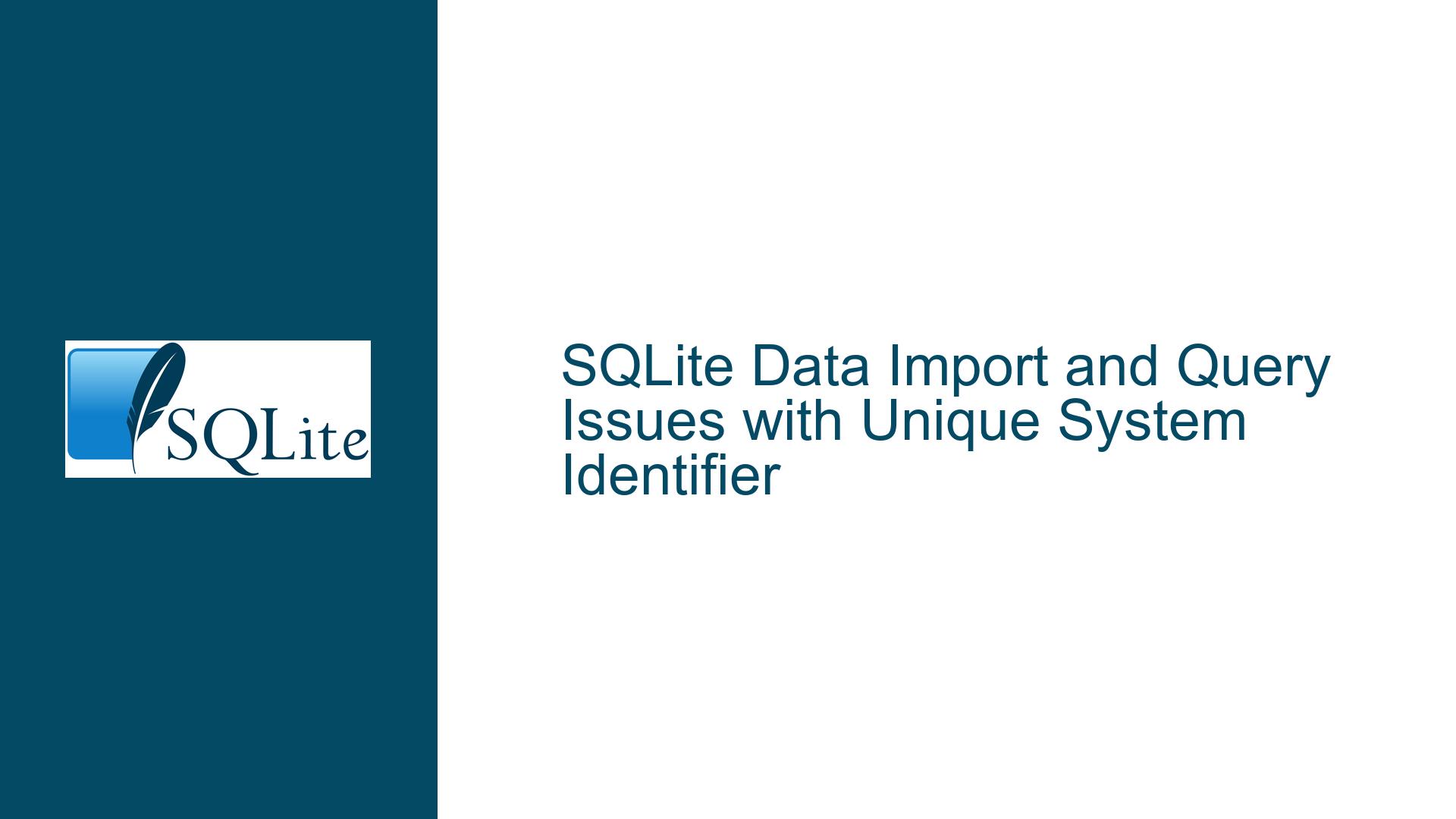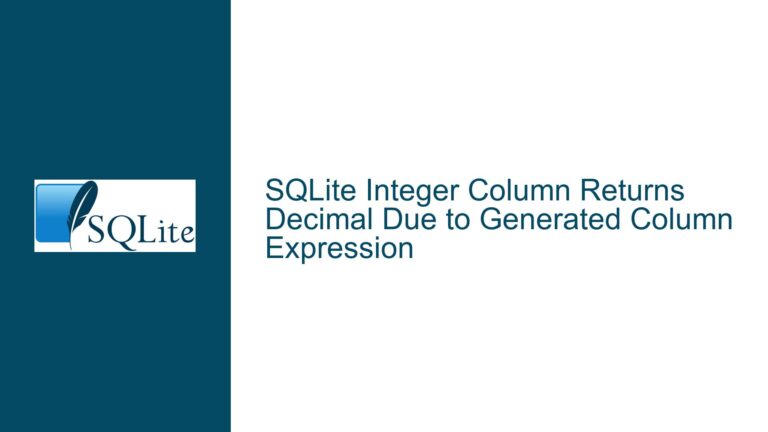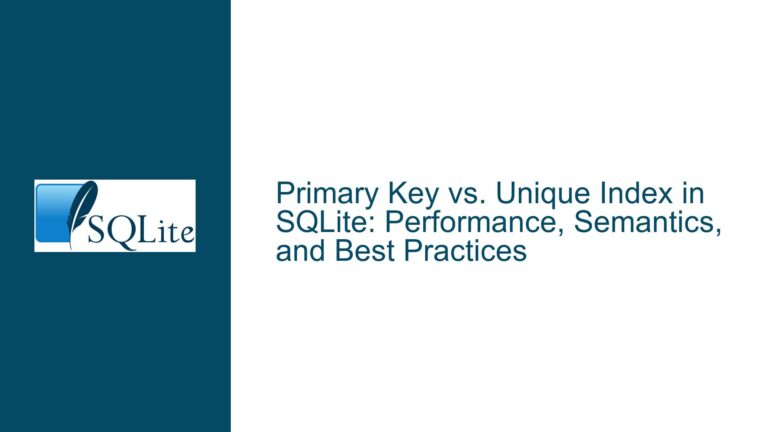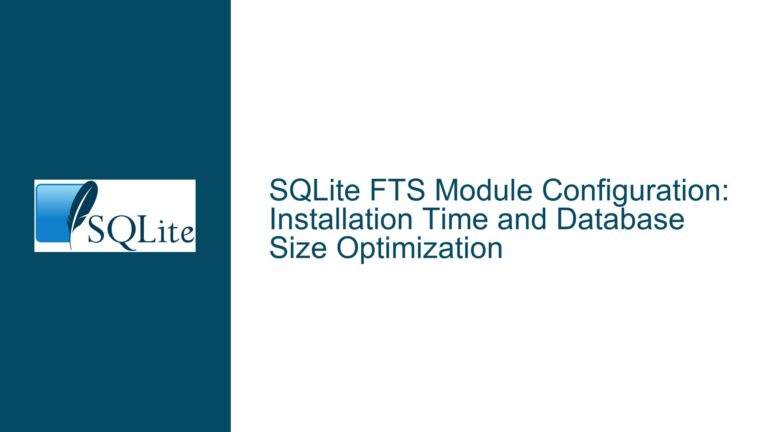SQLite Data Import and Query Issues with Unique System Identifier
Data Import Errors and Schema Misalignment
The core issue revolves around the improper import of a large dataset into an SQLite database, leading to unexpected query results. The dataset, sourced from an FCC amateur radio call sign database, is stored in a .dat file with a pipe (|) delimiter. The schema for the fcc table is designed to accommodate 30 columns, but the import process encounters errors due to malformed data, such as unescaped double quotes and unterminated fields. These errors cause SQLite to misinterpret the data, resulting in incomplete or incorrect records being inserted into the table.
The schema definition for the fcc table includes fields like unique_system_identifier, call_sign, and entity_name, among others. Indexes are created on call_sign and unique_system_identifier to optimize query performance. However, the import process fails to correctly map the data to the schema, leading to inconsistencies. For example, the query SELECT * FROM fcc WHERE unique_system_identifier='4350131'; returns over 1,000 records, which is unexpected since unique_system_identifier is supposed to be a unique key. This suggests that the data import process did not properly enforce the schema constraints, leading to duplicate or misaligned records.
The import errors reported by SQLite include issues like "unescaped " character" and "expected 30 columns but found 29." These errors indicate that the data file contains fields with embedded delimiters or missing values, which SQLite cannot parse correctly without proper escaping or formatting. The result is a database that appears to have valid data but behaves unpredictably when queried.
Malformed Data and Incorrect Query Results
The root cause of the query issues lies in the malformed data within the .dat file. The file uses a pipe (|) delimiter but does not follow standard CSV formatting rules, such as escaping double quotes or handling missing values. For example, a line in the file might look like this: EN|4350131|||KM0BUL|L|L02375253|Bulla 495, Kerry "|Kerry|"|Bulla|495||||5835 Best Rd|Larkspur|CO|80118|80118|Kerry "Mark" Bulla|000|0029933348|I||||||. Here, the double quotes within the entity_name field are not escaped, causing SQLite to misinterpret the field boundaries.
When the data is imported into SQLite, these malformed lines lead to incorrect record insertion. For instance, the query SELECT * FROM fcc WHERE unique_system_identifier='4350131'; returns multiple records because the import process did not correctly parse the unique_system_identifier field. Instead, it may have treated part of the malformed data as part of the identifier, leading to duplicate entries. Similarly, queries for unique_system_identifier values beyond a certain point return no records, indicating that the import process truncated or misaligned the data.
The indexing mechanism further complicates the issue. While indexes are created on call_sign and unique_system_identifier, they are built on top of the incorrectly imported data. As a result, the indexes do not accurately reflect the underlying data, leading to inefficient or incorrect query results. For example, a query for a specific call_sign might return no records, even though the data exists in the table, because the index points to the wrong locations.
Data Cleaning and Proper Import Techniques
To resolve these issues, the data must be cleaned and properly formatted before importing it into SQLite. One approach is to convert the .dat file into a well-formed TSV (Tab-Separated Values) or CSV file, ensuring that all fields are correctly delimited and escaped. This can be achieved using tools like sed or Python scripts to preprocess the data. For example, the following sed command can be used to clean the data:
sed -e 's/\r//g' -e 's/"/""/g' -e 's/|/","/g' -e 's/^/"/g' -e 's/$/"/' < EN.dat > EN_cleaned.csv
This command removes carriage returns, escapes double quotes, replaces pipes with commas, and adds quotes around each field. The resulting EN_cleaned.csv file can then be imported into SQLite using the .import command with the --csv option:
sqlite> .mode csv
sqlite> .import EN_cleaned.csv fcc
Alternatively, a Python script can be used to preprocess the data and insert it directly into the SQLite database. This approach provides more control over the data cleaning process and ensures that the schema constraints are enforced. For example:
import csv
import sqlite3
# Open the input and output files
with open('EN.dat', 'r') as infile, open('EN_cleaned.csv', 'w') as outfile:
reader = csv.reader(infile, delimiter='|')
writer = csv.writer(outfile, quoting=csv.QUOTE_ALL)
for row in reader:
writer.writerow(row)
# Connect to the SQLite database
conn = sqlite3.connect('fcc.db')
cursor = conn.cursor()
# Import the cleaned data
with open('EN_cleaned.csv', 'r') as f:
reader = csv.reader(f)
for row in reader:
cursor.execute('INSERT INTO fcc VALUES (?, ?, ?, ?, ?, ?, ?, ?, ?, ?, ?, ?, ?, ?, ?, ?, ?, ?, ?, ?, ?, ?, ?, ?, ?, ?, ?, ?, ?, ?)', row)
conn.commit()
conn.close()
This script reads the .dat file, cleans the data, and inserts it into the fcc table in the SQLite database. By ensuring that the data is properly formatted and aligned with the schema, the script avoids the issues caused by the malformed import process.
Once the data is correctly imported, the queries should return the expected results. For example, the query SELECT * FROM fcc WHERE unique_system_identifier='4350131'; should return a single record, and the indexes on call_sign and unique_system_identifier should function as intended. Additionally, the database will be more efficient and reliable, as the data will be properly structured and indexed.
In conclusion, the issues with the SQLite database stem from the improper import of malformed data. By cleaning the data and using proper import techniques, these issues can be resolved, resulting in a well-functioning database that returns accurate and efficient query results.






